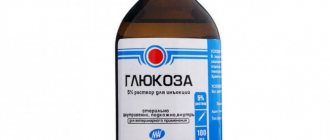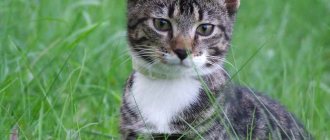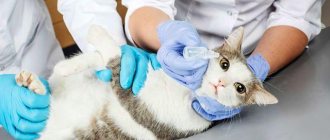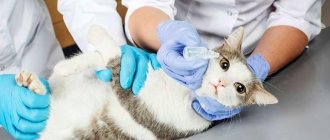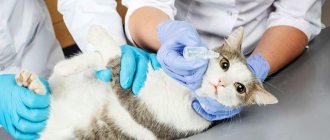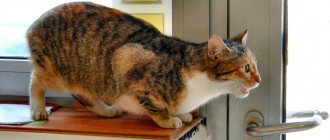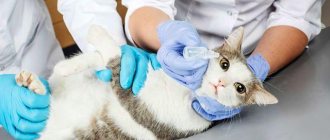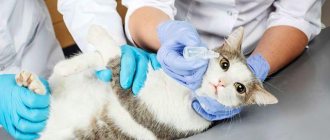Diabetes mellitus in cats is one of the most common diseases of the hormonal system, which is based on a violation of carbohydrate metabolism. The pathology mainly occurs in older animals, more often in neutered cats than in cats. In this article we will talk about why diabetes occurs in cats, why it is dangerous, and how to treat it.
What is diabetes mellitus?
Glucose is the body's fuel and provides energy to the body. Every cell of the body needs it; if it doesn’t receive it, it stops working and dies. Glucose enters the body with food, is processed in the intestines and absorbed into the blood. Then it is picked up by the hormone insulin, which is produced by the pancreas, and carried to the cells, where it binds to their receptors. Through them, insulin transfers glucose to tissues.
If the cell cannot absorb sugar, it remains in the blood and goes into fat reserves. When the body begins to starve and needs glucose, reverse reactions are triggered, during which fat is converted back into fuel.
Diabetes mellitus develops when:
- The pancreas produces too little insulin, and there is not enough of it to provide all cells with glucose. Pathological processes develop in tissues that have not received fuel. They begin to die and cause a malfunction in the body.
- Cell receptors lost sensitivity to insulin, stopped taking glucose from it, and began to starve against the background of high blood sugar.
How long cats with diabetes live depends on the owner. If an animal is treated, it will live a long time. If the disease is ignored, he will die soon.
How to draw the drug into a syringe
When everything you need is prepared and is at hand, you need to carry out the procedure using the following steps:
- Open the syringe and draw up the medicine by piercing the rubber stopper of the bottle with the tip of the needle.
- Draw the drug into a printed syringe in the prescribed amount.
- If prescribed by a doctor, mix glucose with other components according to the veterinarian’s prescription.
- Check the amount of medicine according to their doses.
- Release excess air from the syringe filled with medicine.
It should be said that after the stage of drawing the drug into the syringe, it is recommended to call one of the family members for help for further actions.
It is also important to ensure that the pet does not drink glucose or other medications while the owner is preparing for the injection.
Types of diabetes
There are 2 types of diabetes mellitus in cats:
- The first type - the cells of the pancreas are destroyed, and it produces insulin in critically small quantities.
- The second type (90% of cases) – body cells lose sensitivity to insulin and stop taking up glucose. In response, the pancreas reduces insulin production, at a certain stage the process becomes irreversible.
Clinically, the forms are difficult to distinguish from each other. The only difference is that type 2 diabetes in cats can be reversed with timely treatment, type 1 diabetes cannot be reversed, it can only be slowed down. If the disease is not treated, the consequences differ little - the pet will face disability and death.
Indications for use
The appearance of the pharmaceutical product depends on the manufacturing company and the presence of other components.
Doctors prescribe regular glucose in tablets, as well as its combination with ascorbic acid, for:
- During pregnancy
- Breastfeeding
- Avitaminosis and hypovitaminosis
- Increased need for vitamin C and glucose
In addition, the medication is necessary for children during periods of intensive growth.
Glucose is excellent for recovery after severe pathology and physical activity.
Causes of diabetes in cats
Diabetes mellitus in cats is a multifactorial disease, the development of which often involves several causes. Among them:
- Genetic predisposition – Burmese, Siamese, Russian Blue, Norwegian Forest, Abyssinian cats.
- Poor nutrition – a diet with a lot of carbohydrates (added grains, sugar).
- Overweight.
- Sedentary lifestyle.
- Endocrine diseases. First of all, these are pathologies of the pancreas. In 30% of cases, cats with diabetes have acromegaly, a disease of the pituitary gland, which is accompanied by increased production of growth hormone in an adult animal.
- Treatment with glucocorticoids.
- Urinary tract infections and inflammation of the oral cavity can cause diabetes in a cat due to the constant synthesis of stress hormones.
- Age – pathology often occurs in animals after 8 years.
- Gender – Males are more likely to get the disease than male cats.
Diabetes mellitus in cats: symptoms
The kidneys are responsible for removing toxins from the body, incl. excess glucose. Sugar has the ability to attract water. When glucose enters the urine, it takes with it fluid that should have remained in the body. As a result, dehydration develops. Hence, thirst and frequent urination in diabetes mellitus.
Other signs of diabetes in cats:
- Weakness of the hind limbs due to impaired nerve conduction and decreased muscle tone. Hence the plantigrade gait (a healthy cat walks on its toes) and problems with jumping.
- Tendency to bacterial diseases, primarily urinary tract infections.
- Severe hunger - a symptom of diabetes in a cat develops due to the fact that the cells are starving from a lack of glucose.
- Weight loss - the body begins to extract energy from fat reserves and muscles.
Another symptom of diabetes mellitus in cats is the smell of ammonia. It occurs when the liver breaks down fats, extracting ketone bodies, one of the elements of which is acetone. If there is too much of this substance (advanced stage), the animal begins to emit a specific odor. If the owner does not react urgently and does not call a veterinarian, the pet will soon die.
Analogues, advantages and disadvantages
If we look at it in detail, a drug that has a similar composition and the same therapeutic effect, with corresponding pharmacokinetics (the interaction of a drug and a living organism) and pharmacodynamics (localization, mechanism of action and therapeutic effect) can be considered an analogue of a drug. In other words, if we talk about a drug like “catozal”, the analogue must have the same composition, be prepared using the same high-tech equipment, with appropriate quality control and have exactly the same therapeutic effect.
Therefore, correctly speaking, there are no analogues; there are medicines that are similar in composition and effect on the body. But, in any case, their effect will differ, often for the worse, from the original.
Similar, in this sense, can be considered:
- "Gamavit" - contains B12 and amino acids, stimulates metabolism and supports the liver. The effect is somewhat similar, but has differences. It is more supportive, but less stimulating. There is no focus on normalizing mineral balance. Manufactured by Micro-plus, Russia.
- “” – contains cattle spleen extract (complex of amino acids), the result of use is similar to “Gamavit”, but wider. Produced by “Ekokhimtekh”, Russia.
- “Phos-bevit” – butaphosphan plus vitamins: folic acid, nicotinamide and B12. , Ukraine. Has a similar effect.
- "Vetozal" - B12 and butaphosphan, a similar effect. Produced by OLCAR, Ukraine.
- "Immunovital" - butophosphamide plus B12, a similar effect. Manufactured by Basalt, Ukraine.
- "Roborante" - potassium, amino acids, B12. The action is closer to “gamavit” and “nucleopeptide”. , Spain.
- "Butofan" - butaphosphan and B12 in the composition, a similar effect. , Russia.
- "Cyanophore" - the composition is the same, the effect is similar. Ukraine.
- "Yuberin" - all the same. The action is similar. Manufactured by BELEKOTEHNIKA, Russia.
- "Butozal" - the composition and effect are similar. Manufactured by Interchemie, Holland.
- "Vitabutan" - similar action and composition. , Türkiye.
These are perhaps the most common (you can find more), similar in composition and effects on the body, drugs. It all depends on what action you expect as a result of application. If you just need to support the animal’s body, but the price does not allow you to buy “katozal”, then you can use any of them. How easy it is to get by using B vitamins.
If you expect to get exactly the same therapeutic effect as the original, with a minimum of side effects, then you need to purchase “catozal”, and made in Europe.
Diagnosis of diabetes mellitus in cats
The diagnosis is made based on signs of diabetes in the cat and blood tests:
- For sugar. Glucose in the blood of cats with diabetes increases, but the analysis cannot be used as a reliable diagnosis. The fact is that blood sugar in cats rises quickly under any stress, incl. when visiting a veterinary clinic.
- Fructosamine is a blood protein that binds to glucose, forming a stable compound. In diabetes mellitus, its level rises. The protein circulates in the blood for 2-3 weeks, so recent stress does not affect its concentration.
The value of fructosamine testing is reduced if the cat has hyperthyroidism (overactive thyroid gland). A diseased organ accelerates protein excretion, making it difficult to diagnose diabetes.
Blood and urine tests at home
Measuring blood sugar daily at home, when the cat is calm and relaxed, will help make an accurate diagnosis. Human blood glucose meters can be used for this. Then you need to show the results to the doctor.
A urine test for ketone bodies will help determine the pathology. The diagnostic test can be purchased at a human pharmacy. It will not show the disease at the initial stage, but if the pathology progresses, it will detect ketone bodies.
How to take blood from a cat to test for sugar?
The most convenient way to collect blood from a cat is from the auricle. To see the vessels, the ear is illuminated with a flashlight. Before taking blood, you cannot disinfect your ear!
Blood can also be taken from the paw pads.
- Use any medical or veterinary blood glucose meter.
- Turn on the glucometer and insert a test strip into it.
- Pierce the ear or paw pad with a needle. Wait for a drop of blood to appear, then apply the test strip to the drop of blood.
- Insert the strip into the glucometer and wait for the result.
- Treat the puncture site with chlorhexidine.
Tip: If blood spreads across the ear, shave it or lubricate the fur with a thin layer of Vaseline.
Diabetes mellitus in cats: treatment
Timely treatment of diabetes mellitus in cats can, if not reverse, then stop the progression of the disease. If treatment is delayed and the symptoms of diabetes in cats are ignored, the prognosis is poor. Irreversible consequences will begin in the animal’s body, which will lead to disability and death.
If a cat has diabetes mellitus, the first thing to do is listen to the doctor and follow all the recommendations. Main methods of treatment:
- diabetes medications (insulin);
- special diet.
Insulin therapy
To treat diabetes in cats, insulin is prescribed to help control blood glucose levels throughout the day. Animal-based insulin is better suited for cats - bovine or pork (Caninsulin).
Synthetic human insulin is absorbed less well and is excreted faster, for example, it lasts not 24 hours, but 12. Among drugs of this type, Levemir and Lantus have shown good results.
How to treat diabetes in cats: injections or tablets
The tablets stimulate the pancreas, improving insulin synthesis, so they are not very effective if the gland is not working (in type 1 pathology). In addition, frequent use of pills can aggravate the condition of the pancreas and damage the liver.
Insulin injections do not give such a reaction. The hormone immediately enters the bloodstream, bypassing the pancreas, causing less damage to the liver. For this reason, doctors recommend insulin injections.
Importance of dosage
Before treating diabetes mellitus in a cat, it is necessary to correctly set the dose of insulin. The difficulty is that when an animal visits a doctor, its blood sugar rises due to stress. Therefore, the dose is prescribed based on measurements taken by the owner at home. If the cat owner is unable to do the test during the day, the dosage is prescribed based on the level of fructosamine in the blood.
In most cats, positive dynamics begin a few days after taking insulin. The recommended dose is 1-2 injections per day.
The importance of monitoring your pet's condition
A sick cat should have its blood and urine glucose levels measured daily. Keep in mind that different brands of insulin affect cats differently. Some medications may last less, while others may last longer.
Monitoring blood glucose levels will help adjust the dose, depending on the type of insulin and the health of the cat. The data obtained during the measurements must be recorded in a diary. It must indicate:
- insulin injection time;
- medication dosage;
- blood and urine sugar levels;
- quantity and time of feeding;
- volume of liquid drunk;
- cat's weight (once a week).
The veterinarian will need this data in order to adjust the treatment regimen in time. You cannot change the dosage yourself if the cat feels better or worse. Moreover, it is forbidden to stop taking insulin without your doctor’s instructions.
Insulin overdose: consequences
If you give your cat too much insulin, his blood glucose levels may drop to critical levels (hypoglycemia). Symptoms:
- weakness and lethargy;
- shiver;
- staggering (drunk gait);
- convulsions;
- loss of consciousness;
- vomit;
- loss of bladder control.
Hypoglycemia is a deadly condition that requires urgent medical attention. To revive your cat while you wait for the doctor, rub honey on her gums.
Mode of application
Children over three years of age and adults can take the classic form of the drug, 0.5-1 tablets three times a day. If the doctor considers it necessary to prescribe a combined form of the drug (with ascorbic acid), the dosage must be recalculated, taking into account the content of vitamin C in the tablet. Typically, the dose for treatment varies from 50 to 100 mg per day 3-5 times a day.
For preventive purposes, adult patients are allowed to take up to 100 mg of the drug per day. Children 6-14 years old should not take more than 50 mg of the drug per day.
It is important to understand that the dosage and duration of therapy must be adjusted by the attending physician.
Nutrition for cats with diabetes
In case of diabetes mellitus, special attention should be paid to nutrition:
- You need to feed your pet 4 times a day at the same time.
- When scheduling feedings and injections, you need to calculate the time when insulin in the blood is at its highest level (usually 3 hours after the injection). Feed as follows: give 2 snacks before the injection, 2 (main feeding) - 3 hours after the injection.
- Give preference to a diet with a low amount of carbohydrates (up to 5%), from which the body extracts glucose.
What to feed a cat with diabetes
The diet should be based on lean meat - beef, lamb, chicken, turkey, which are the main source of protein. Don't forget about vegetables (carrots, cabbage, zucchini), which slow down the absorption of glucose. Salt, spices, pasta, smoked meats, and other food from the master's table are prohibited.
Do not mix:
- natural food with industrial food;
- drying and canned food.
Provide the animal with constant access to water.
Cat food for diabetes
It is better to regulate your cat's glucose with a low-carbohydrate diet, so buy special medicated food. Take a product that belongs to the super-premium and holistic class. Cheaper products are high in carbohydrates (cereals), so they are not suitable for diabetes.
Never buy economy food, especially if your pet is sick. They have an unbalanced composition, a lot of harmful substances, grains that can cause a sharp jump in sugar.
pharmachologic effect
Glucose (dextrose) belongs to the category of monosaccharides. The substance is found in the juice of various berries (in particular grapes), which is why it is sometimes called grape sugar.
Oligosaccharides and disaccharides consist of glucose units.
Once in the digestive system, complex saccharides break down into fructose and glucose.
Glucose, as a monosaccharide, is found in:
- Lymph
- Blood
- Myocardium
- Skeletal muscles
Glucose is a participant in carbohydrate metabolism and affects metabolism.
Dextrose is necessary for carbohydrate nutrition of muscles and brain; the substance is well and quickly absorbed and helps improve human performance.
Prevention of diabetes
- Monitor your cat's weight and prevent obesity.
- Pay attention to a balanced diet. Remember that the cat is a carnivore, so meat should dominate the menu. Reduce the amount of carbohydrates. If you feed artificial food, it must be of high quality.
- Provide your pet with plenty of exercise, especially if he doesn't leave the house. Play with your pet daily, providing moderate exercise.
- Regularly donate your pet's blood and urine for analysis, if there is a genetic predisposition, the pet is over 7 years old.
- Treat illnesses in a timely manner. If the pathology requires the use of steroids, reduce their amount to a minimum, especially if the pet is obese.
